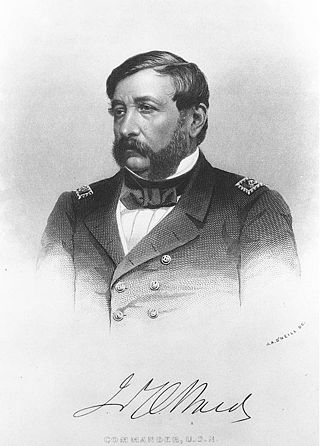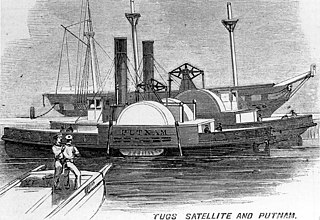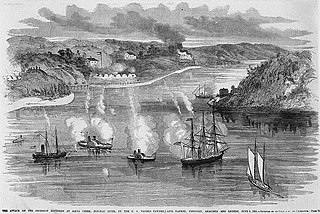
The Peninsula campaign of the American Civil War was a major Union operation launched in southeastern Virginia from March to July 1862, the first large-scale offensive in the Eastern Theater. The operation, commanded by Major General George B. McClellan, was an amphibious turning movement against the Confederate States Army in Northern Virginia, intended to capture the Confederate capital of Richmond. McClellan was initially successful against the equally cautious General Joseph E. Johnston, but the emergence of the more aggressive General Robert E. Lee turned the subsequent Seven Days Battles into a humiliating Union defeat.

Commander James Harmon Ward was the first officer of the United States Navy who was killed during the American Civil War.

The first USS Pawnee was a sloop-of-war in the United States Navy during the American Civil War. She was named for the Pawnee Indian tribe.

CSS Teaser had been the aging Georgetown, D.C. tugboat York River until the beginning of the American Civil War, when she was taken into the Confederate States Navy and took part in the famous Battle of Hampton Roads. Later, she was captured by the United States Navy and became the first USS Teaser.
The Battle of Sewell's Point was an inconclusive exchange of cannon fire between the Union gunboat USS Monticello, supported by the USS Thomas Freeborn, and Confederate batteries on Sewell's Point that took place on May 18, 19 and 21, 1861, in Norfolk County, Virginia in the early days of the American Civil War. Little damage was done to either side. By the end of April 1861, USS Cumberland and a small number of supporting ships were enforcing the Union blockade of the southeastern Virginia ports at the southern end of the Chesapeake Bay and had captured several ships which attempted to pass the blockade. USS Monticello's bombardment of the Sewell's Point battery was one of the earliest Union Navy actions against Confederate forces during the Civil War. While it has been suggested by some sources that the Monticello's action may have been the first gunfire by the Union Navy during the Civil War, a brief exchange of cannon fire between the U.S. gunboat USS Yankee and shore batteries manned by Virginia volunteer forces which had not yet been incorporated into the Confederate States Army at Gloucester Point, Virginia on the York River occurred on May 7, 1861.

The Battle of Cockpit Point, the Battle of Freestone Point, or the Battle of Shipping Point, took place on January 3, 1862, in Prince William County, Virginia, as part of the blockade of the Potomac River during the American Civil War.

The 22nd Regiment Massachusetts Volunteer Infantry was an infantry regiment in the Union army during the American Civil War. The 22nd Massachusetts was organized by Senator Henry Wilson and was therefore known as "Henry Wilson's Regiment." It was formed in Boston, Massachusetts, and established on September 28, 1861, for a term of three years.

USS Satellite was a large, steam-powered large tugboat, acquired by the Union Navy during the American Civil War and equipped with two powerful 8-inch guns. She was assigned to the Union blockade of the Confederate States of America.
USS Yankee was a steam-powered side-wheel tugboat acquired by the Union Navy just prior to the outbreak of the American Civil War.

USS Jacob Bell was a sidewheel steamer acquired by the Union Navy for use during the American Civil War. She was one of the oldest vessels so acquired. Her duties included river patrols, guard duty, and other duties as assigned.

USS Ice Boat was a vessel borrowed from the City of Philadelphia, Pennsylvania, by the Union Navy when the American Civil War suddenly broke out. She was placed in service immediately and kept in service until she could be replaced by Union Navy vessels, built or borrowed, and then returned to Philadelphia.
USS Anacostia was a steamer, constructed as a tugboat, that was first chartered by the United States Navy for service during the Paraguay crisis of the 1850s and then commissioned as a U.S. Navy ship. She later served prominently in the Union Navy during the American Civil War.

The first USS Resolute was a steamer acquired by the Union Navy during the American Civil War.

USS Underwriter was a 341-ton sidewheel steamer that was purchased for military use by the Union Navy during the American Civil War.

USS Aroostook was a Unadilla-class gunboat built for the Union Navy during the American Civil War. Aroostook was used by the Navy to patrol navigable waterways of the Confederacy to prevent the South from trading with other countries.

USS Thomas Freeborn was a steam tug acquired by the Union Navy during the American Civil War. She was used by the Navy as a gunboat to patrol navigable waterways of the Confederacy to prevent the South from trading with other countries.

The Potomac Flotilla, also called the Potomac Squadron, was a unit of the United States Navy created in the early days of the American Civil War to secure Union communications in the Chesapeake Bay, the Potomac River and their tributaries, and to disrupt Confederate communications and shipping there.
The Battle of Gloucester Point, Virginia was the first reported exchange of fire in the American Civil War, following the surrender of Fort Sumter. As Lincoln extended the Union blockade to include Virginia, the rebels tried to deny Union access to the local estuaries. On May 7, 1861, Lieutenant Thomas O. Selfridge Jr. commanding the USS Yankee was ordered to reconnoitre the new fortifications at Gloucester Point opposite Yorktown. Shots were exchanged, causing no casualties, Selfridge claiming that his guns were too small to damage the battery, commanded by Lieutenant John Thompson Brown, credited with firing the first cannon shot of the war in Virginia.
The Battle of Pig Point, Virginia was an early naval battle of the American Civil War, after Lincoln had extended the Union blockade to include Virginia. On June 5, 1861, the Union gunboat USRC Harriet Lane under Captain John Faunce was ordered to attack Pig Point, but due to shallow water, the shots fell short, and the Union suffered five men wounded before withdrawing.
The Battle of Mathias Point, Virginia was an early naval action of the American Civil War in connection with the Union blockade and the corresponding effort by the Confederates to deny use of the Potomac to the enemy.

![Action between the U.S. vessels Pawnee and Freeborn and the rebel batteries at Acquia [sic] Creek. By Alfred R. Waud of Harper's Weekly. Battle of Aquia Creek.png](http://upload.wikimedia.org/wikipedia/commons/thumb/1/17/Battle_of_Aquia_Creek.png/200px-Battle_of_Aquia_Creek.png)














